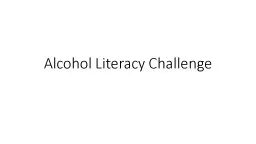

Alcohol Literacy Challenge Summarized Class room based curriculum Goals Alter expectations of alcohol correct erroneous beliefs about the effects of alcohol decreasing positive and increasing negative expectancies ID: 586542
Download Presentation The PPT/PDF document "Alcohol Literacy Challenge" is the property of its rightful owner. Permission is granted to download and print the materials on this web site for personal, non-commercial use only, and to display it on your personal computer provided you do not modify the materials and that you retain all copyright notices contained in the materials. By downloading content from our website, you accept the terms of this agreement.
Slide1
Alcohol Literacy ChallengeSlide2
Alcohol Literacy Challenge Summarized
Class room based curriculum
Goals =
Alter expectations of alcohol/ correct erroneous
beliefs about the effects of alcohol, decreasing positive and increasing negative expectancies.
R
educe frequency of alcohol use in high school and college
Reduce quantity of alcohol use in high school and college
Taught in one 90 minute class or two 45 minute classes by a thoroughly trained presenter.
Can be implemented in middle, high school and collegeSlide3
The Theory Behind Alcohol Literacy Challenge
Expectancy Theory
One of the most wildly accepted theories of what motivates us to engage in a behavior.
Began with
Tolman
in 1932- the theory that animals (including humans) develop expectancy or anticipation of rewards for completing behaviors they have learned, and this expectancy functions as an internal incentive or motivation
Expanded by
MacCorquodale
and
Meehl
in 1953- the relationship between a stimulus, response and outcome does not have to be performed in order to be learned
BASICALLY….YOU DO NOT NEED TO HAVE EXPERIENCED SOMETHING TO LEARN A CAUSE AND EFFECT RELATIONSHIP….SIMPLY SEEING IT CREATES A STRONG LEARNING EXPERIENCES THAT GETS DEEPLY INGRAINED IN THE BRAIN.
WHAT THIS MEANS IS….A CHILD’S BRAIN THAT TAKES IN HOW COOL DRINKING IS THROUGH MILLIONS OF REPETITIONS OF ADVERTISEMENT WILL LEARN THAT COOL= DRINKING JUST LIKE PAVLOV’S DOG LEARNED BELL= FOOD.Slide4
•
Expectancies correlates with drinking (Goldman & Dunn 1996)
• Appear in children before they being drinking (Goldman & Dunn 1998)
• Change in a direction that encourages drinking when approaching
adolescence (Goldman & Dunn 2000
)
Expectancy manipulation results in increase or decrease in drinking
(Darkes & Goldman 1993 & 98, Dunn 2000, Stein 2000)• Predicts drinking prospectively for as much as nine years (Newcomb1988, Stacy 1991)• When measured with treatment predicts post treatment outcome(Conners 1993)• Expectancy changes parallel changes in drinking behavior (Sher 1996)• Expectancies rather than chemical effects appear responsible for somebehavior changes when drinking (Martin & Sayette 1993)
Why Talk About Expectancies in Alcohol Prevention…….Slide5
EXPECTANCIES ARE A SORT OF PLACEBO EFFECT (IF you believe it ..it will occur.)
Here are other ways the placebos work and are used in the industrySlide6
What occurs during ALC implementation
Students get to learn about expectancies and other psychological processes
Students learn the true effects of alcohol
Students learn how the media can skew perceptions
Students are challenged to identify inaccuracies in media
Students learn to deconstruct ads
Students learn to think critically about media messaging, how and why particular advertisements are created
Students learn that they can get all the positive effects that they think come from alcohol…without drinkingStudents learn the power they have over how they experience something.Slide7
Efficacy of This Program
This program is listed in NREPP (National Registry of Evidence Based Programs and Practices)
Research indicates that it reduces
positive alcohol
expectancies when implemented in Elementary School
(
Cruz, I. Y. & Dunn, M. E. 2003) High School (Cruz, I. Y. 2006 )
and College
(
Sivasithamparam
, J., Hall, T.V., Dunn, M.E.
June,
2008)(
Schreiner, A., Fried, A., Sivasithamparam, J., &
Dunn,
M.E
. August, 2009
)
(
Sivasithamparam, J.
Schreiner,
A
., Boucher, A., Dunn, M.E., & Hall, T.V. November, 2010
)
Research indicates that it reduces alcohol consumption in high school students
(
Cruz
, I.
Y.2006),
College students
(
Sivasithamparam
, J., Hall, T.V., Dunn, M.E. June,
2008)
(
Schreiner
, A., Fried, A., Sivasithamparam, J., & Dunn,
M.E.
August
, 2009
)
Research indicates that it
r
educes
binge drinking
episodes
(
Sivasithamparam
, J., Hall, T.V., Dunn, M.E. June, 2008)Slide8
NOTE
While ALC studies in middle school have been completed, they have not been able to be published on account of sample size being impacted by school drop out or student drop out. However, results with the available
sample sizes
have been positive as per Dr. Debenedittis.
Dr. Debenedittis expressed interest in working with Tykes and Teens Prevention Services in hopes to support future studies on ALC with middle school students here in Martin County.Slide9
Why we want to implement this program vs. other….
It decreases the burden on our teachers and school personnel
Fidelity rises as program implementation is provided by specialized Tykes and Teens staff
The program moves beyond simple awareness and education but impacts cognitive systems
Allows us to impact children at various developmental levels
Provides the opportunity to have more of a reach in our community as research shows its impact up into college
Cost effective with greater reach
Allows opportunity to expand on other prevention endeavorsSlide10
For More Information Contact
Ms. Dot Brooking
Prevention Coordinator
772-220-3439
Dot@tykesandteens.org